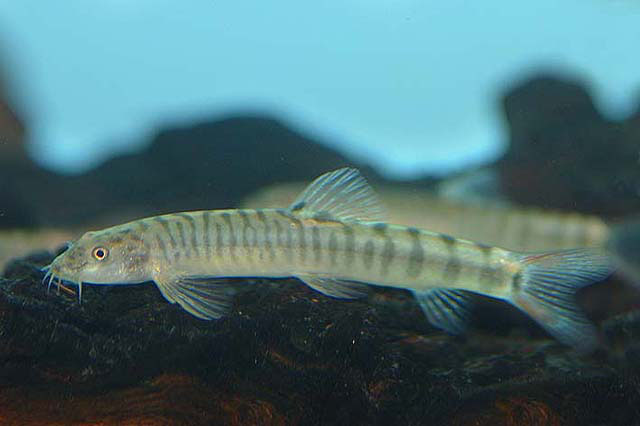| Nemacheilidae (Brook loaches) |
| 5.9 cm SL (male/unsexed) |
|
benthopelagic; freshwater |
| Asia: Chao Phraya in Thailand (Ref. 12041), Mekong basin in Laos and Thailand, northern Mae Nam Ping basin in Thailand and Salween basin in Thailand and Myanmar (Ref. 43281). |
|
Dorsal soft rays (total): 12-12; Anal soft rays: 8-8. Distinguished by its color pattern: the bars in front of dorsal fin are conspicuously thinner than those behind, usually united in pairs (or more) at their upper extremity. This color pattern is shared with a few other species in area; S. poculi is distinguished from S. vinciguerrae by 8+7 branched caudal rays (versus 9+8), from S. mahnerti and S. bella by the absence of sexual dimorphism (both species have a well developed suborbital flap in males ) and by details of the color pattern (Ref. 39226). |
| Occurs in brooks and streams with swift current, among large pebbles, stones and boulders (Ref. 39226). Found in creeks and streams with moderate current and clear water (Ref. 43281). A 4.82 cm SL female contained nearly ripe ovulae, about 1.3 m diameter; when collected, a 5.22 cm SL female extruded yellow-orange ovulae; one of them still adheres to its genital opening (Ref. 39226). |
|
Least Concern (LC); Date assessed: 09 July 2011 Ref. (130435)
|
| harmless |
|
Occurs in Mae Nam Ping basin at Chiang Mai Province, Salween basin at Mae Hong Son Province, Mekong basin at Chiang Mai and Chiang Rai Provinces (Ref. 39226), Chao Phraya and Maeklong basins (Ref. 26336). In the Mekong basin, known from Chiang Mai Province in Pong Nam Ron, in Nam Mae Mao at Ban Huai Phak Phai, in Nam Mae Chai and in Mae Nam Kok at Thaton; and from Chiang Rai Province in Nam Mae Lao, in Pang Meton, in Nam Tok Khun Koan and in Nam Mae Lao (Ref. 39226); also from Khon Kaen, Sakon Nakhon and Kanchanaburi (Ref. 37773). Also Ref. 1632, 12041, 26580, 43281. |
Source and more info: www.fishbase.org. For personal, classroom, and other internal use only. Not for publication.

